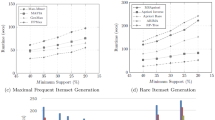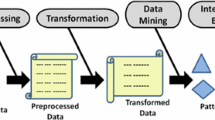Abstract
Various data mining methods have been proposed to handle large-scale data and discover interesting knowledge hidden in the data. Maximal frequent pattern mining is one of the data mining techniques suggested to solve the fatal problem of traditional frequent pattern mining approach. While traditional approach may extract an enormous number of pattern results according to threshold settings, maximal frequent pattern mining approach mines a smaller number of representative patterns, which allow users to analyze given data more efficiently. In this paper, we describe various recent maximal frequent pattern mining methods using additional factors and conduct performance evaluation in order to analyze their detailed characteristics.





Similar content being viewed by others
References
Agrawal R, Srikant R (1994) Fast algorithms for mining association rules. In: 20th international conference on very large data bases, pp 487–499
Cho Y, Moon S (2015) Recommender system using periodicity analysis via mining sequential patterns with time-series and FRAT analysis. J Converg 6(1):9–17
Gaur M, Pant B (2015) Trusted and secure clustering in mobile pervasive environment. Human-centric Comput Inf Sci 5(32):32:1–32:17
Goparaju A, Brazier T, Salem S (2015) Mining representative maximal dense cohesive subnetworks. Netw Model Anal Health Inform Bioinform 4(1):29
Grahne G, Zhu Z (2005) Fast algorithms for frequent itemset mining using FP-trees. IEEE Trans Knowl Data Eng 17(10):1347–1362
Han J, Pei J, Yin Y, Mao R (2004) Mining frequent patterns without candidate generation: a frequent-pattern tree approach. Data Min Knowl Discov 8(1):53–87
Jeeva S, Rajsingh E (2016) Intelligent phishing url detection using association rule mining. Human-centric Comput Inf Sci 6(10):10:1–10:19
Karim M, Rashid M, Jeong B, Choi H (2012) Privacy preserving mining maximal frequent patterns in transactional databases. In: 17th international conference on database systems for advanced applications, pp 303–319
Lee G, Yun U, Ryang H, Kim D (2016) Approximate maximal frequent pattern mining with weight conditions and error tolerance. Int J Pattern Recognit Artif Intell 30(6):1650012:1–1650012:42
Li H, Zhang N (2016) Probabilistic maximal frequent itemset mining over uncertain databases. In: 21st international conference on database systems for advanced applications, pp 149–163
Necir H, Drias H (2015) A distributed maximal frequent itemset mining with multi agents system on bitmap join indexes selection. Int J Inf Technol Manag 14(2/3):201–214
Nikam S (2015) A comparative study of classification techniques in data mining algorithms. Orient J Comput Sci Technol 8(1):13–19
Nourine L, Petit J (2016) Extended dualization: application to maximal pattern mining. Theor Comput Sci 618:107–121
Salem S, Ozcaglar C (2013) MFMS: maximal frequent module set mining from multiple human gene expression data sets. in: 12th international workshop on data mining in bioinformatics, pp 51–57
Sanna G, Angius A, Concas G, Manca D, Eros F (2015) PCE: a knowledge base of semantically disambiguated contents. J Converg 6(2):10–18
Sato A, Huang R, Yen N (2015) Design of fusion technique-based mining engine for smart business. Human-centric Comput Inf Sci 5(23):23:1–23:16
Stattner E, Collard M (2012) MAX-FLMin: an approach for mining maximal frequent links and generating semantical structures from social networks. In: 23rd international conference on database and expert systems applications, pp 468–483
Wang F, Hu L, Zhou J, Hu J, Zhao K (2017) A semantics-based approach to multi-source heterogeneous information fusion in the internet of things. Soft Comput 21(8):2005–2013
Yun U, Lee G (2016) Incremental mining of weighted maximal frequent itemsets from dynamic databases. Expert Syst Appl 54:304–327
Yun U, Ryu K (2013) Efficient mining of maximal correlated weight frequent patterns. Intell Data Anal 17(5):917–939
Yun U, Lee G, Lee K (2016) Efficient representative pattern mining based on weight and maximality conditions. Expert Syst 33(5):439–462
Zhang D, Niu H, Liu S (2016) Novel PEECR-based clustering routing approach. Soft Comput 1:1–11. doi:10.1007/s00500-016-2270-3
Acknowledgements
This study was funded by the Ministry of Education, Science and Technology of the National Research Foundation of Korea (NRF No. 20152062051 and NRF No. 20155054624).
Author information
Authors and Affiliations
Corresponding author
Ethics declarations
Conflicts of interest
Gangin Lee declares that he/she has no conflict of interest. Unil Yun declares that he has no conflict of interest.
Ethical standards
This article does not contain any studies with human participants or animals performed by any of the authors
Additional information
Communicated by J. Park.
Rights and permissions
About this article
Cite this article
Lee, G., Yun, U. Performance and characteristic analysis of maximal frequent pattern mining methods using additional factors. Soft Comput 22, 4267–4273 (2018). https://doi.org/10.1007/s00500-017-2820-3
Published:
Issue Date:
DOI: https://doi.org/10.1007/s00500-017-2820-3




